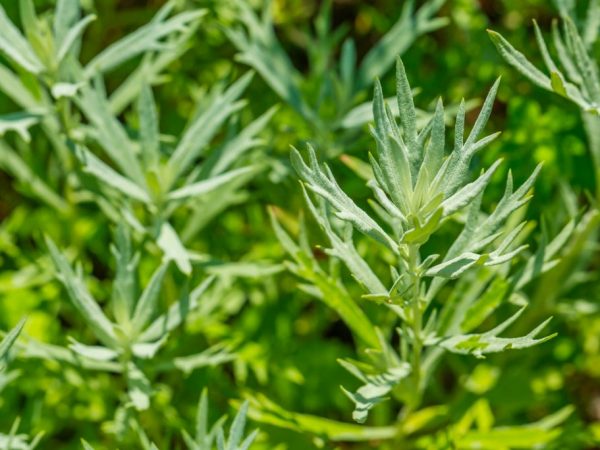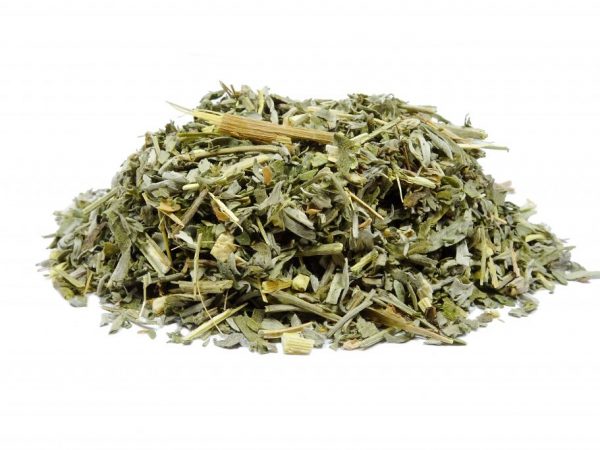Citrine wormwood
Wormwood belongs to a large genus of the same name of herbaceous plants from the Aster family.

Citrine wormwood
Botanical characteristic
Citrine wormwood is a Compositae plant, is a perennial desert shrub growing up to 0.7 m in height. Has a peculiar smell. It is poisonous. Biological description:
- woody tap root system with dark brown color;
- 10-12 erect woody reddish stems branching in the upper part;
- alternate leaves pinnately dissected into small narrow-linear lobes, while the lower tier has a petiole appearance, length 3-6 cm, pubescent, painted in gray color, falls off by the beginning of flowering, the upper leaf layer is small, sessile, whole;
- inflorescences of small size, ovoid, formed by bisexual flowers with a diameter of 2-3 mm, collected in a compressed panicle-type basket, there is no calyx, the flowering period falls on the first days of September and lasts about 10 days;
- in gray fruits, an ovoid achene is formed, convex on one side, 1.0-1.6 mm long, the period of seed ripening begins at the end of October.
Has another name - darmina. Propagated by seed and by means of shoots.
Chemical composition
The chemical composition of the aboveground part of the desert darmina contains:
- up to 7% santonin, which is one of the sesquiterpene esters of hydroxy acids;
- 1.5-3.0% of essential oil, 70-80% consisting of terpenes, including menthane oxide (cineole) and 5-7% of thujyl alcohol;
- camphor terpenoid;
- carvacrol.
Geography of distribution
Citrine wormwood is endemic. Distributed in the Central Asian area, more precisely - in the southern part of Kazakhstan and Tajikistan. It is found in river valleys, grows in large tracts along the Syr Darya, Arys and others rivers, and is present on plains, deserts and foothill regions. The semi-shrub plant does not tolerate excessively humid places, preferring carbonate and saline soil soils.
Practical use

Wormwood is used for medicinal purposes
Citrine wormwood is used for medicinal purposes; flowers collected in an unblown state at the stage of bud formation in the form of flower baskets are used as a medicinal raw material. Darmina baskets are an antihelminthic agent due to the chemical composition of santonin, which has anthelmintic properties.
Wormwood flowers are often mistakenly referred to as citrine seed.
The essential oil obtained from the plant is a potent bactericidal agent with anti-inflammatory, analgesic and irritating properties. It is used for external use to relieve pain symptoms in rheumatism, nerve pinching, musculoskeletal spasms and lumbago in the lumbar region (lumbago).
The use of the plant for medicinal purposes is strictly controlled, becausewhen consumed in large doses, it has a toxic effect on the body, causing changes in the state of brain neurons.
By its properties, wormwood oil is similar to eucalyptus. It has a regenerating effect on the cellular composition, is capable of arresting allergic attacks, acts as a protective agent for the stomach in the course of oxidative reactions. Helps with heartburn and flatulence. Acts as a preventive measure against stomatitis and gingivitis. It is used in aromatherapy for fumigating rooms for disinfecting purposes.
In folk medicine, wormwood flowers are consumed with the addition of honey and sugar, which makes it possible to neutralize the plant bitterness.
Pharmacological medicinal homeopathic preparations made on the basis of darmina seed allow to normalize metabolic processes, increase appetite and act as a regulator of hemoglobin levels in the blood, acting as a remedy against anemia. They also have a calming effect on the central nervous system, neutralizing depression, chronic fatigue and panic attacks.
Contraindications
Contraindications to the use of flowers and essential oil:
- diseases of the circulatory system,
- ulcerative exacerbations, duodenal ulcer disease,
- pregnancy and lactation,
- renal failure.
In case of an overdose, citrine wormwood causes diarrhea, leads to bouts of nausea and vomiting, provokes headaches and stomach cramps, is the cause of xanthopsia (when the surrounding objects are seen in yellow shades) and a decrease in the quality of smell. An overdose of the use of wormwood is reduced to dilated pupils, an increased heart rate, sleep disturbances and a drop in blood pressure. With the most severe intoxication, it leads to the appearance of convulsive states.
Conclusion
For a long time, the seeds and flowers of citrine wormwood were used as an anthelmintic drug. Today, the scope of application of the plant in folk medicine and pharmacology has been expanded, and its medicinal properties are used in the treatment of gynecological and dermatological pathologies, neuralgia and anemia. The plant is poisonous, because its use is strictly dosed.



